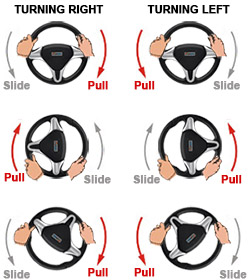Steering a Car Tutorial
On your driving test, when steering a car, the examiner will expect you to:
- Hold the steering wheel at either the ten-to-two or quarter-to-three position.
- Steer smoothly and at the correct time.
- Avoid crossing your hands over one another when turning.
- Avoid letting the wheel spin back through your hands when straightening up.
- Avoid weaving in and out between parked cars.
- Obey lane markings.
You must keep both hands on the steering wheel all the time the car is moving unless operating another hand control or giving a signal. You should never take both hands off the wheel while the vehicle is moving.
To steer a straight course, look well ahead – you will always tend to go where you are looking. You must be able to operate the main controls without looking at them and away from the road. Looking down to locate any such controls will result in the vehicle wandering from side to side.
Pull Push Steering

To turn the car, you should use the ‘push-pull’ method. This means feeding the steering wheel through your hands so that one hand remains gripping the wheel.
For example, to turn right, pull the steering wheel downwards with your right hand, and at the same time, slide your left hand down the rim so that both hands end up at the same height on the wheel. Then change the grip to your left hand and push the wheel further round, at the same time allowing your right hand to slide up the rim of the wheel.
You may need to repeat these steps according to the angle through which the front wheels need to turn.
Dry Steering
Turning the steering wheel when the car isn’t moving is called dry steering. This is something you should try and avoid as it puts undue strain on the steering mechanism and causes premature wear to the front tyres. If carrying out a low speed manoeuvre, such as turning in the road, you should get the car moving before you start to steer.
Steering Lock
When you turn the steering wheel as far as it will go it is at full lock. This is the maximum angle the front wheels will reach. On full lock the car’s turning circle is at it’s smallest.
Safety Tip
When removing a hand from the steering wheel to operate other controls such as the radio, always make sure you are steering straight ahead, as steering around a bend with only one hand on the wheel makes it much more difficult to accurately steer the car.
Power-Assisted Steering (PAS)
Nearly all cars have PAS fitted as standard. It makes steering a car much easier as less physical effort is needed to turn the steering wheel. It is especially useful when manoeuvring a car at low speeds, so it is a great help when parking in tight spaces, etc.
